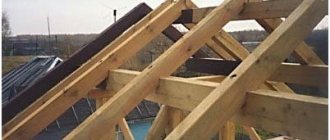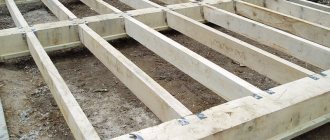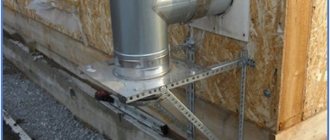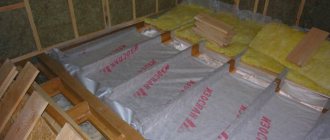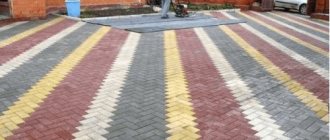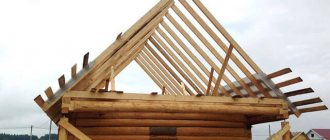The elements are made only from high-quality coniferous wood, treated with special protective compounds.
The correctness and strength of the connections, as well as the accurate calculation of the rafters carried out before starting work, are important.
How to do the job correctly?
The future roof should not only reliably protect the house from precipitation and other weather conditions, but also serve as a decoration for the building. Therefore, when choosing a rafter system option, climatic factors are taken into account, and installation is carried out in a certain order, allowing the structure to be beautiful, durable and stable.
All work is carried out in several stages:
The preliminary step is to create a template for the selected type of rafter system.
Two boards are lifted onto the ceiling, their ends are connected, and the others are spread apart and installed on the support beam.Fix the selected angle by installing a transverse jumper.
- The manufacture of rafters begins.
To do this, the template is lowered to the ground, making sure that the angle of the rafter legs is maintained. The first rafter is lifted onto the building and installed as a base. - The next stage of work is carried out at height. To do this, mark the cut location on the mauerlat and rafters. After preparing the cut, the production of the next rafter begins.
- After the two trusses are ready, they are installed at the edges, after which a cord is pulled between them. This is how the level of installation of intermediate rafters is determined.
- They begin to assemble the remaining trusses. The step between them should be about 80 cm. Assembly is carried out directly on the beams.
- The final stage of work includes the installation of supports and cross bars, installation of vapor barrier systems, waterproofing and thermal insulation. Lastly, install the sheathing (the base for attaching the roofing material).
Useful tips
- The correct fastening of the rafters is no less important than the correct calculation of the structure. Before installing a roof yourself, you should take a lesson from an experienced carpenter and read educational literature.
- When choosing the pitch of the rafters, do not forget about thermal insulation. All types of insulation can shrink a little, so you can buy them by approximate size. The most commonly produced sizes are 60, 80, 100, 120 cm.
- For roofs with a slope of 45 degrees or more, the weight of a person on the roof can be ignored. This removes 175 kilograms of the design load per square meter and allows rafters to be installed on average 20% less often.
- Snow and wind loads in the regions of Russia can be found out from regulatory documents - maps in Appendix G to SP 20.13330.2011 “Loads and impacts”.
- There are many online roof calculators on the web that can, if not correctly calculate all the nuances, then at least advise you on choosing the right section for the rafters.
Mounting methods
The rafter fastening scheme is simple. It consists of parallel boards laid with support on two walls of the log house. For proper installation of rafter legs, transitional wooden elements are used.
You can choose the method of attachment to the mauerlat (beam laid at the base of the walls), to the top of the wall, and also use the top trim.
The rafter legs are installed obliquely at a certain angle. To make the fastening strong, the contact area of the individual elements is artificially increased in two ways:
- make cuts;
- saw down the upper and lower edges of the rafter legs.
The pitch of the rafters depends on the type of material and ranges from 60 to 90 cm. Installation of the rafter system is carried out according to the following scheme:
- Installation of load-bearing beams along the wall of the building. Roofing felt is laid along the end of the building, and prepared timber is placed on it.
- When preparing the beams and rafters, plan for the boards to extend above the roof overhang. The departure distance depends on the angle of the slope and is about 40 cm.
- The board is embedded into the Mauerlat for strength.
Summary
It’s not enough to know how to install rafters and secure them to the walls of the house. First you need to calculate the loads and choose the optimal fastening method, taking into account the length of the spans, the possibility of shrinkage and other factors affecting the stability and durability of the structure being created. And most importantly, you need to have experience working with wood and be a perfectionist in order to achieve the perfect identity of each pair of rafters and install them in the same plane.
You can take on such work yourself if you have a detailed project in hand and an experienced assistant nearby. Otherwise, it makes sense to turn to professionals.
Ratings 0
Fixing the rafter leg
A rafter leg is an element of a rafter or load-bearing system. It is an inclined beam that forms the basis of the frame.
The sheathing is attached to it, as well as thermal insulation, vapor barrier, and waterproofing systems, providing a comfortable atmosphere in the house.
This is the main component of the roof, which forms the slopes and angles of inclination.
The rafter legs take on the main load and distribute it evenly over the roof area. There are two known types of fastening rafter legs to the Mauerlat:
- Rigid or immovable
- Sliding (based on hinges) provides mobility and takes the load when the building shrinks.
In the design of a pitched roof, mainly sliding type of fastenings of rafter legs are used, since the probability of shrinkage of the building under the influence of climatic phenomena is quite high.
The sliding type of fixation makes it possible to take into account factors under the influence of which fastening units can be destroyed. In addition, it is possible to move the parts relative to each other to some extent.
Thus, the rafters are given the opportunity to adapt to the shrinkage of the walls.
Detailed video instructions
The video will show you the process of constructing a rafter system for a pitched roof:
We looked at the most typical examples that are relevant and accessible for personal execution. The technological nuances of typical situations were described in detail. These are basic options that can easily become the basis for your own developments. Dimensions change due to individual needs, but the principles of constructing rafter frames for pitched roofs are stable. Knowing them is useful for both independent craftsmen and owners who want to competently supervise the work of builders.
Types of fixation
Main types of fixation:
- If the roof is erected over a building with walls of equal height, it is classified as a layered one.
- If the slope is formed by a rafter triangle, then a hanging type of rafter legs is used.
In this case, they are fixed in the usual way, since their horizontal side rests on the Mauerlat and the joining area is quite significant (without cutting).
If the layered rafter legs are installed at an angle to the supporting fixation elements, then their contact area with the Mauerlat is too small. In order to increase the contact area and protect against movement, a notched fixation method is used.
By sawing the upper or lower edge of the rafter leg, the support area increases significantly, and, as a result, the stability of the connection increases. The cut can be made vertically or horizontally .
Recommendations for strengthening knots
Depending on how the rafters should be secured, fastening units with different degrees of freedom can be used:
Single degree of freedom fastening means that the rafter only rotates slightly around the fastening point.- Mounting with two degrees of freedom . In addition to rotation, a small displacement in the horizontal direction is also provided.
- Fastening units with three degrees of freedom - in addition to rotation and horizontal displacement, they also include displacement in the vertical direction.
Despite some possibility of movement, the rafters remain fixed quite rigidly. They must withstand the load placed on them.
For buildings of all types, a general scheme is followed: if one of the rafter nodes has a rigid fastening, then the paired one has a certain degree of freedom. This ensures displacement in the event of increased pressure.
The following types of node circuits are used:
- Rigidly fixed top and articulated bottom. It is used when installing roofs over extensions and on those objects where the difference in the height of the supporting walls is significant.
- The top and bottom are articulated and fixed. The scheme is used on isolated buildings whose walls have already undergone shrinkage.
The upper knot is made in the form of a triangular notch, the lower one - with a notch resting on the Mauerlat. - Free top and hinged-fixed bottom. The scheme is used for rafters with hanging edges and for extensions.
- Both nodes are movable. Used if fastening connections have a first or second degree of freedom.
- Rigid fastening to an inclined harness. Used in frame construction. Can be used for pitched roofs built over a concrete or brick building. It is considered the simplest and most accessible.
The main advantages of pitched roofs
Despite the fact that not everyone likes the aesthetics of a building over which a pitched roof is installed (although the question itself is ambiguous), many owners of suburban areas, when constructing buildings, and sometimes even a residential building, choose this option, guided by a number of advantages similar design.
Single-pitch roofing systems impress with their clarity, ease of calculation and installation
- Very little materials are required for a single-pitch rafter system, especially if it is being built over a small outbuilding.
- The most “rigid” flat figure is a triangle. It is this that underlies almost any rafter system. In a single-slope system, this triangle is rectangular, which greatly simplifies calculations, since all geometric relationships are known to everyone who graduated from high school. But this simplicity does not in any way affect the strength and reliability of the entire structure.
- Even if the owner of the site conducting independent construction has never encountered the construction of a roof before, the installation of a lean-to rafter system should not cause him undue difficulties - it is quite understandable and not so complicated. Often, when covering small outbuildings or other adjacent structures, it is quite possible to do without not only calling a team of specialists, but even without inviting assistants.
- When erecting a roof structure, the speed of work is always important, naturally, without loss of quality - you want to protect the structure from the vagaries of the weather as quickly as possible. In terms of this parameter, the pitched roof is clearly the “leader” - its design has virtually no complex connecting units that take a lot of time and require high-precision adjustment.
How significant are the disadvantages of a lean-to rafter system? Alas, they exist, and they also have to be taken into account:
- An attic with a pitched roof is either not intended at all, or it turns out to be so small that one has to forget about its wide functionality.
In the vast majority of cases, a pitched roof does not imply the presence of a “useful” attic space
- Based on the first point, there are certain difficulties in ensuring sufficient thermal insulation of rooms located under a pitched roof. Although, of course, this can be corrected - nothing prevents you from insulating the roof slope itself or placing an insulated attic floor under the rafter system.
- Shed roofs, as a rule, are made with a slight slope, up to 25–30 degrees. This has two consequences. Firstly, not all types of roofing are suitable for such conditions. Secondly, the significance of the potential snow load increases sharply, which must be taken into account when calculating the system. But with such slopes, the influence of wind pressure on the roof is significantly reduced, especially if the slope is positioned correctly - in the windward direction, in accordance with the prevailing winds in a given area of the area.
On the Internet you can find many projects of residential buildings, in which the main emphasis is on the shed roof system
- Another drawback, perhaps, can be classified as very conditional and subjective - this is the appearance of a pitched roof. It may not be to the liking of lovers of architectural delights, they say, it greatly simplifies the appearance of the building. This can also be objected to. First, the simplicity of the system and the cost-effectiveness of construction often play a decisive role in the construction of auxiliary structures. And three times - if you look at the overview of residential building projects, you can find very interesting design options in which the emphasis is placed specifically on the pitched roof. So, as they say, there is no arguing about tastes.
Types of fasteners
When fastening the rafters of a pitched roof, three types of fasteners are used: fastening hardware, wooden connecting elements and metal elements. Let's take a closer look.
Fastening hardware
Fastening hardware involves driving or screwing into wood . When connecting rafters to a mauerlat or top trim, use:
- Rough nails 150-200 mm long. This method appeared a long time ago and is simple.
- U-shaped roofing brackets. The method is also reliable and simple.
- Self-tapping screws.
- Bolts. They secure through fasteners.
Wooden connecting elements
Wooden connecting elements are used for sliding fastenings. This method is used for houses made of timber.
The entire structure has the ability to “breathe” under the influence of weather conditions. The following elements apply:
- Gussets are triangular overlays that follow the shape of the angle of attachment of the ridge and rafters.
- Crossbars are wooden boards with edges cut to the angle of the rafters.
- Pins are a wooden fastening element that works in shear.
Metal parts
Metal fasteners made of galvanized steel are used in modern buildings. They are reliable, strong and durable.
Additionally, passivated connecting elements are used that are well protected from corrosion. The following types of fastenings are used:
- Metal corners for wood.
- Perforated metal plates (used to fasten rafters at the joint).
- Metal asymmetrical corner.
Advantages and disadvantages
Shed roofs are considered the most inexpensive and easiest to install. And this is true, especially with the small width of the building. However, in our country, houses with pitched roofs are very rare. For the most part, this is due to the fact that two or four pitched roofs are more familiar to us - they look more familiar. The second snag is to find a project adapted to our weather conditions. There are a lot of projects on Western resources, but they are designed for a milder climate and, as a rule, have a large glazing area. Finding an architect who will competently change a project you like is very difficult. But if you succeed, and the harmony of the building is not disturbed, the house turns out to be very original.
One of the projects of houses with a pitched roof
Many people are afraid of uneven ceilings in some parts of the building. They are, of course, more difficult to beat than standard ones, but the result is of a completely different level - 100% original. True, this time it is very difficult to find a designer who can develop such an interior in the vastness of our Motherland, but nevertheless, it is possible.
There is another way out - to level the ceilings by overlapping, and use the free space under the roof as technical rooms. Such options have been implemented and the owners are very satisfied. Yes, the technical rooms are on the ground floor and upstairs, but there are no problems with groundwater.
These are, perhaps, all the disadvantages or pitfalls that a pitched roof can bring. There is, however, one more point that can hardly be called a disadvantage. Due to the peculiarity of the structure, the roofing material on such houses is not visible from the ground. If the terrain is flat, without large differences in elevation, there is no point in bothering with the appearance of the roof. It is better to choose simple-looking, but high-quality materials, quiet (the flat surface is large, it makes a lot of noise when it rains) and reliable. One of the popular options is seam roofing. It provides the proper degree of tightness and is not very noisy. Another option is a soft fused roof made from modern materials. Such roofs are even quieter, and modern materials can be used for 20-30 years without repair.
Nuances when building a shed
When building a barn roof, the rafter legs are attached to the load-bearing walls or to the mauerlat. To increase the length, so-called fillies are used - overhang bars.
Depending on the type of construction, three types of rafter legs are used. They transfer the load to the walls and foundation in different ways:
Sliding rafters are used to build a barn made of timber.
Their upper part is rigidly fixed. The lower one has a free fastening to a metal element (the so-called slip).Such a roof is not afraid of shrinkage of the building. It has the ability to fall without deforming.
- Layered rafters are placed on a brick or block structure that has internal partitions. This design is poorly adapted to loads.
- Hanging rafters do not have additional supports. They transfer all the load to the external walls. The roof truss is assembled on the ground and lifted up in finished form.
During the installation of the rafter legs, the gable and rear legs are first installed, and then, focusing on the stretched line, the rest are installed.
The distance between the rafters should not exceed a meter.
Then additional overhangs (fillies) and the last lathing are installed.
Calculation of material quantity
The number of beams depends on the total area of the roof and the laying pitch.
The length of the roof overhang is divided by the approximate pitch of the rafters. The result obtained is rounded upward and one is added. This is how the number of rafters is obtained. To find out the exact distance between the elements, divide the length of the cornice by the number of rafters.
Calculation example:
- overhang length 27 m, approximate gap 0.8 m;
- calculating the number of rafters: 27 / 0.8, you get 33.75 (34) pieces, add 1, you get the number of 35 pieces;
- exact interval: 27 / 35 = 0.77 m.
The number of battens is determined by dividing the length of the ramp by the step distance. The total length of the boards or slats is calculated by multiplying their number by the length of the overhang. Take into account that in difficult junction areas, ridge areas, and on the eaves, double sheathing is installed.
Features when building a canopy
A shed roof is erected over an extension to a house or a canopy, adjacent to the wall or roof of the main building. The lower ends are attached to the Mauerlat in the usual way. The peculiarity is in the installation of the upper part of the rafter legs.
- As a preliminary step, the required angle of inclination is determined.
- Then, taking into account the angle of difference, a wooden structure made of timber is installed.
- The fastening of the rafter frame to the wall of the main building must be movable, since due to different shrinkage rates cracks may occur
- An elastic layer of polyurethane foam or other soft material with low thermal conductivity is laid between the beam and the wall.
- If the roof of the canopy is adjacent to the roof of the main building, then the adjacent slope is dismantled and rafter legs are installed from the ridge of the main roof to the mauerlat of the extension.
To seal the junction of the rafter legs to the roof or wall, install a roofing apron (a strip with flaps that seals joints and seams).
